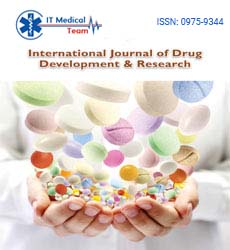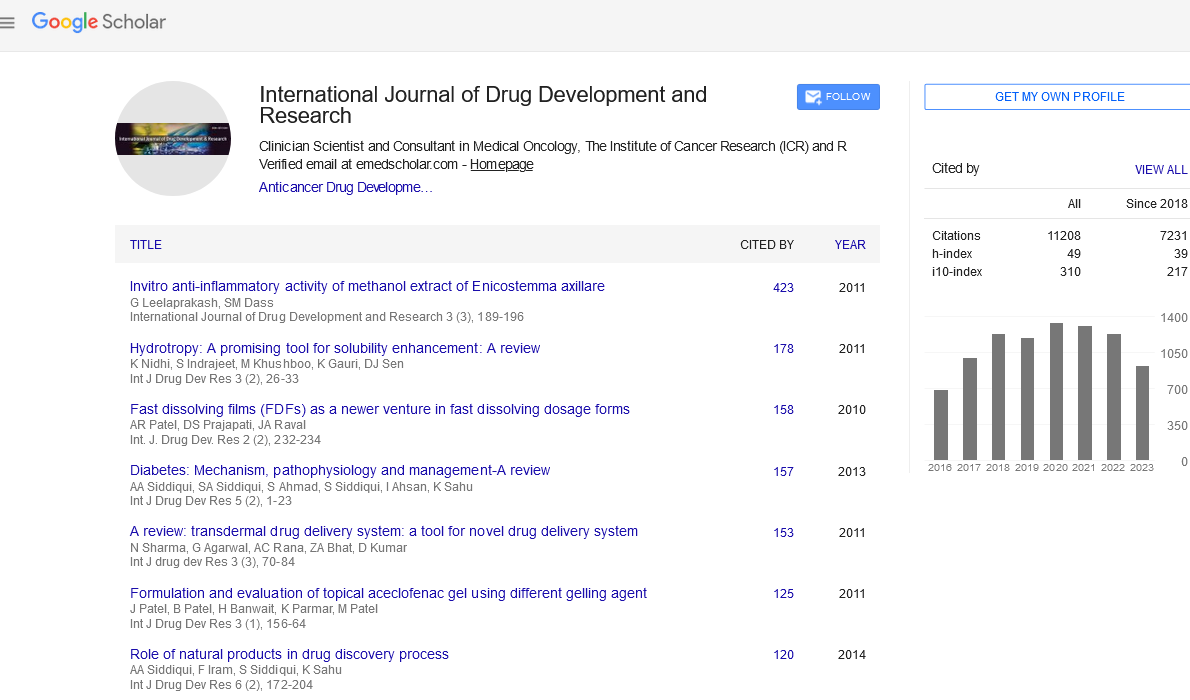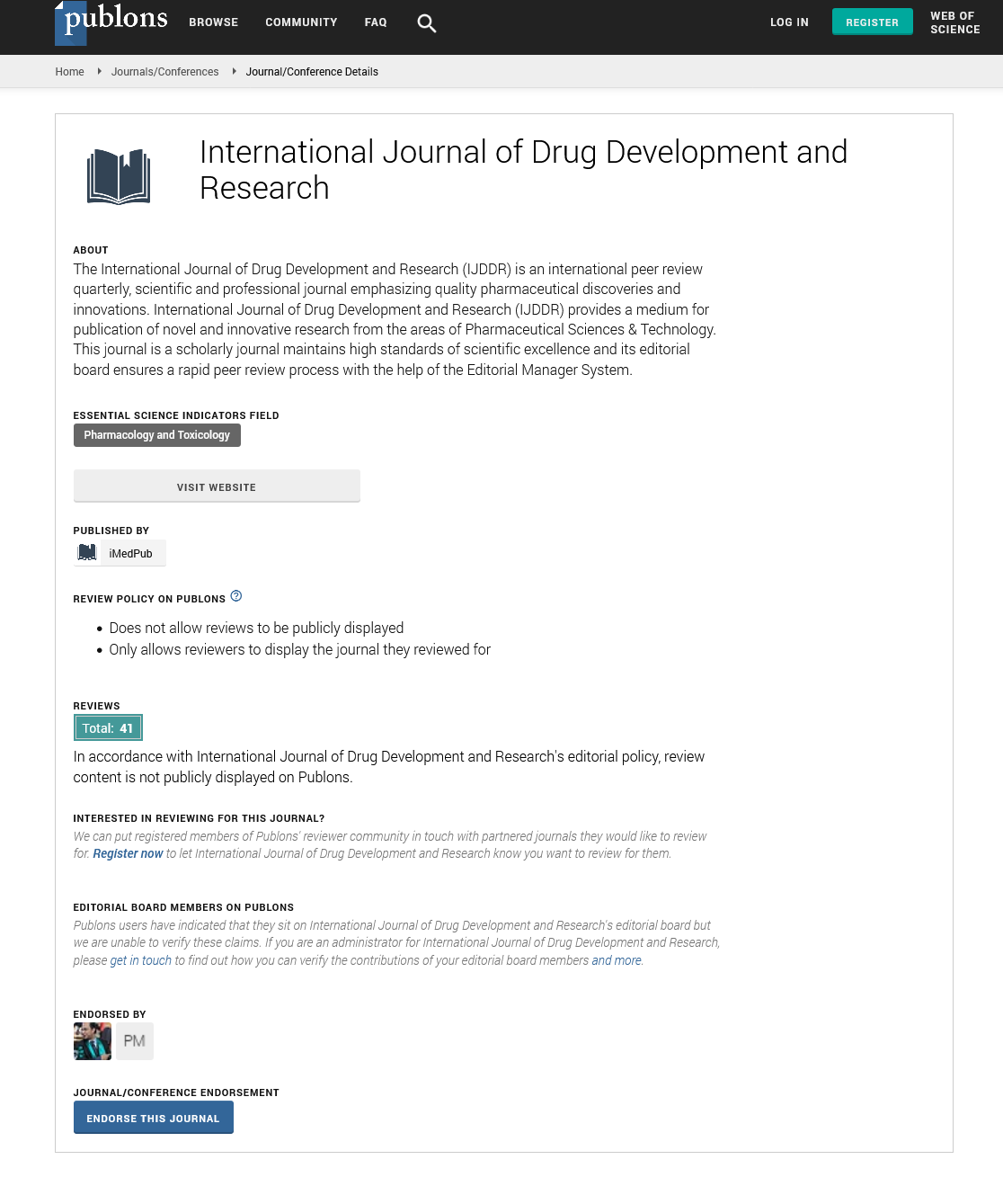Key words
|
| |
| Eleusine indica, antiplasmodial, malaria, Plasmodium berghei, antidiabetic, alloxan |
| |
INTRODUCTION
|
| |
| Panicum maximum.Jacq ( poacace) is a perennial, tuft grass with a short, creeping rhizome regarded as the most valuable fodder plant and extensively used to make hay. The stem of this robust grass can reach a height of up to 2m. the leaf sheath are found at the bases of the stems and are covered in fine hairs. It is widely distributed in Africa where it originates and almost all tropical parts of the world [1]. The plant (leaf) is use traditionally by the Ibibios of Akwa Ibom State, Nigeria in the treatment of various ailments such as rheumatism pain, inflammation and diabetes. Ethnopharmacological and scientific reports on this plant is scarce. In this study , we investigated the effect of ethanolic leaf extract of Panicum maximum on alloxan induced diabetic rats during single and repeated administrations to observe acute and chronic effects of the extract on blood glucose levels of the diabetic rats in bids to confirm its ethnobotanical uses in the management of diabetes. |
| |
MATERIALS AND METHODS
|
| |
|
Plant materials
Fresh leaves of Panicum maximum were collected in September, 2008 at a farmland in University of Uyo, Uyo, Nigeria. The plant was identified and authenticated by Dr. Margaret Bassey, a taxonomist in the Department of Botany, University of Uyo, Uyo. Nigeria. Herbarium specimen (FPH. 321) was deposited at Faculty of Pharmacy Herbarium. The fresh leaves (2kg) of the plant were dried on laboratory table for 2 weeks and reduced to powder. The powder 100g was macerated in 95% ethanol (300ml) for 72 hours. The liquid filtrate obtained was concentrated in vacuo at 40°C. The yield was 4.83% w/w. The extract was stored in a refrigerator at 4°C until used for experiment reported in this study. |
| |
|
Phytochemical Screening
|
| |
| Phytochemical screening of the extracts was carried out according to standard methods [5,6] . |
| |
|
Animals
|
| |
| Albino wistar rats (125 – 168g) and albino Swiss mice (20-25g) of either sex were obtained from the University of Uyo animal house. They were maintained on standard animal pellets and water ad libitum. Permission and approval for animal studies were obtained from the College of Health Sciences Animal Ethics committee, University of Uyo. |
| |
|
Determination of median lethal dose (LD50)
|
| |
| The median lethal dose (LD50) of the extract was estimated using albino mice by intraperitoneal (i.p) route using the method of Lorke [7] . This involved the administration of different doses of the extract to groups of three mice each. The animals were observed for manifestation of physical signs of toxicity such as writhing, decreased motor activity, decreased body/limb tone, decreased respiration and death. The number of deaths in each group within 24 hours was recorded. The LD50 was calculated as geometrical means of the maximum dose producing 0% (a) and the minimum dose producing 100% mortality (b). |
| |
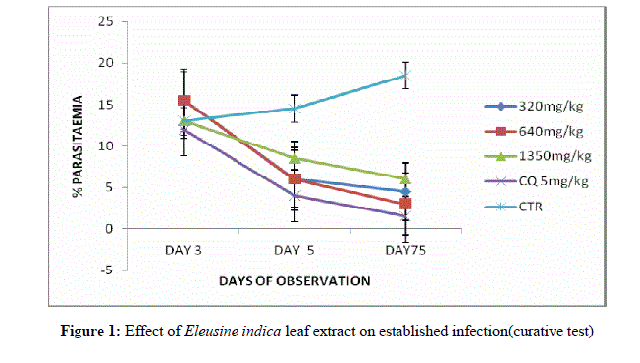 |
| |
|
Parasite inoculation
|
| |
| The chloroquine – sensitive Plasmodium berghei berghei was obtained from National Institute of Medical Research,Lagos, Nigeria and maintained in mice. The inoculum consisted of 5x107 P. berghei berghei parasitized erythrocytes per ml. This was prepared by determining both the percentage parasitaemia and the erythrocytes count of the donor mouse and diluting the blood with isotonic saline in proportions indicated by both determinations. Each mouse was inoculated on day 0, intraperitoneally, with 0.2 mL of infected blood containing about 1 x 107 P. berghei beghei parasitized red blood cells. |
| |
|
Evaluation of Schizontocidal Activity on early infection(4 – day test)
|
| |
| Schizontocidal activity of the extract was evaluated using the method described by Knight and Peters [8] . Each mouse was inoculated on the first day (day 0), intraperitoneally, with 0.2ml of infected blood containing about 1x107 P. berghei berghei parasitized erythrocytes. The animals were divided into five groups of five mice each and orally administered, shortly after inoculation with 320, 640 and 960mg/kg/day doses of the Eleusine indica extract, chloroquine 5mg/kg/day and an equivalent volume of distilled water (negative control) for four consecutive days, (day 0 to day 3). On the fifth day (day 4), thin films were made from the tail blood of each mouse and the parasitaemia level was determined by counting the number of parasitised erythrocytes out of 200 erythrocytes in random fields of the microscope. Average percentage chemosuppression was calculated as 100 [A-B]/A. |
| |
| where A is the average percentage parasitaemia in the negative control group and B, average percentage parasitaemia in the test group . |
| |
|
Evaluation of schizontocidal activity established infection (Curative or Rane test)
|
| |
| Evaluation of curative potential of the extract was done using a method similar to that described by Ryley and Peters[9] . The mice were injected intraperitoneally with standard inoculum of 1x107 P. berghei infected erythrocytes on the first day (day 0). Seventy-two hours later, the mice were divided into five groups of five mice each. The groups were orally administered with Eleusine indica extract (320, 640 and 960mg/kg/day), chloroquine(5mg/kg) was given to the positive control group and an equal volume of distilled water to the negative control group. The drug/extract was given once daily for 5 days. Thin films stained with Giemsa stain were prepared from tail blood of each mouse daily for 5 days to monitor the parasitaemia level. The mean survival time for each group was determined arithmetically by finding the average survival time (days) of the mice (post inoculation) in each group over a period of 28 days (day 0 to day 27). |
| |
|
Evaluation of antidiabetic activity of the extract Induction of diabetes
|
| |
| The animals (male rats) were fasted overnight and diabetes was induced by a single intraperitoneal injection of a freshly prepared solution of Alloxan monohydrate (150mg/kg) in ice cold 0.9% NaCl saline solution. The animals were given 5% dextrose solution to drink immediately after induction to overcome the drug induced hypoglycemia. Control rats were injected with normal saline alone. 72 hours later rats with blood glucose level (BGL) above 200mg/dl were considered diabetic and selected for the experiment. |
| |
| The animals were divided into five groups of 6 rats each and treated as follows: |
| |
| Group I: Diabetic rats administered Eleusine indica extract (320mg/kg/day) acqeous solution orally for 14 days. |
| |
| Group II: Diabetic rats given Eleusine indica extract (640mg/kg/day) in acqeous solution orally for 14 days. |
| |
| Group III: Diabetic rats administered orally with Eleusine indica extract (960mg/kg/day) acqeous solution orally for 14 days. |
| |
| Group IV: Diabetic rats given Glibenclamide (10mg/kg/day) for 14 days orally. |
| |
| Group V: Diabetic control rats. |
| |
| The body weight gain and fasting BGL of all the rats were recorded at regular intervals during the experimental period. For acute study, the BGL was monitored after 1, 3, 5 and 7h of administration of a single dose of the extract and at the end of 1, 3, 5, 7 and 14 days for prolonged treatments. The BGL was monitored in the diabetic rats by tail tipping method. The blood was dropped on the dextrostix reagent pad. This was inserted into microprocessor digital blood glucometer and the readings were noted[10] . |
| |
|
Statistical analysis and data evaluation
|
| |
| Data obtained from this work were analyzed statistically using Students’ t- test and ANOVA (One- or Two - way) followed by a post test (Tukey - kramer multiple comparison test ). Differences between means will be considered significant at 1% and 5% level of significance i.e P ≤ 0.01and 0.05. |
| |
RESULTS
|
| |
|
Phytochemical screening
|
| |
| The results of phytochemical screening of the extract of E. indica reveal that the extract contains alkaloids, terpenes, flavonoids, tannins, anthraquinones, saponins and cardiac glycosides. |
| |
|
Acute Toxicity
|
| |
| The mice were treated intraperitoneally with a single dose of 1-5g/kg of Eleusine indica extract after being starved for 24hours. The route was chosen because of its sensitivity and rapid results. E. indica (1-5g/kg) produced physical signs of toxicity in the animals depending on the dose given ranging from writhing, decreased respiration and death 24 hours after administration of the extract. All the animals administered with 3.5g/kg and above doses of the extract died. The LD50 of the extract was calculated to be 3.24g/kg. |
| |
|
4-day test
|
| |
| Ethanolic extract of Eleusine indica produced a dose dependent chemosuppressive effect at various doses employed in this study. The chemosuppression were 11.11, 66.66 and 74.07 % for 320, 640 and 960mg/kg/day doses. The chemosupression produced by the extract were significant (P<0.05) compared to control and incomparable to that of the standard drug (chloroquine 5mg/kg/day) with a chemosuppression of 88.88% (table 1). |
| |
|
Curative test
|
| |
| On established infection, it was observed that there was a daily increase in parasitaemia of the control group. However, there was a daily reduction in the parasitaemia levels of the extract treated group as well as that of positive control (chloroquine). On day 7, the average percentage parasitaemia for the groups were 4.5, 3.0, 2.0, 1.5 and 18.5 % for 320, 640 and 960mg/kg/day of the extract, chloroquine and control groups respectively (figure 1). The mean survival time (m.s.t) of the extract treated groups were significantly (P<0.05) longer than that of control and was comparable to that of the standard drug, chloroquine. The values are given in table 2. |
| |
|
Antidiabetic activity
|
| |
| A dose-dependent reduction in BGL was observed in alloxan-induced diabetic rats treated with ethanolic leaf extract of Eleusine indica. After a single dose of the extract on the alloxan-induced diabetic rats, there was a significant (P<0.05 – 0.001) reduction in BGL of the diabetic rats within the period of acute study compared to control with the maximum effect at 5h with the highest dose of the extract (960 mg/kg, 58.85% ). However, the effect was less than that of the standard drug, glibenclamide (figure 2). During prolonged study (14 days), the extract produced a sustained significant (P<0.001) reduction in BGL of the diabetic rats compared to control (figure 3). The BGL of the diabetic rats were reduced to normal. The effect of the highest dose of the extract was incomparable to that of standard drug, glibenclamide, 10 mg/kg on day 15. |
| |
DISCUSSION
|
| |
| Eleusine indica was evaluated for its antiplasmodial potentials in Plasmodium berghei infected mice. The acute toxicity test of the ethanolic leaf extract was also carried out. The ethanolic extract of Eleusine indica which had negligible acute toxicity [11] contains alkaloids, terpenes, flavonoids, tannins, anthraquinones, saponins and cardiac glycosides. Thus revealing an enormous medicinal value of this herb. The extract demonstrated a significant (P<0.05) antiplasmodial activity in both early and established infections, which can be attributable to the phytochemical components of the extract like alkaloids, flavonoids and terpenes which already had been implicated in antiplasmodial activity of various plants [12,13]. The antiplasmodial activity of the leaf extract was incomparable to that of the standard drug, chloroquine, due to the crude nature of the extract. Moreso, plants compounds which merely slow down or temporary arrest the growth of the parasite (plasmodistatic) as well as those which act as immune stimulant or helping to alleviate symptoms and reverse some pathological result of malaria infection are reported to potentiate malaria resistance and antiplasmodial activity in immune individuals living in endemic areas[14] . In this study, considerable antiplasmodial activity of the leaf extract was observed. |
| |
| Evaluation of antidiabetic activity of Eleusine indica leaf extract was also carried out in alloxaninduced diabetic rats. The extract which showed moderate toxicity was observed to demonstrate significant antidiabetic activity in alloxan diabetic rats. Some phytochemical compounds such as polysaccharides [15] , terpenes and tannins [16] and steroids [17] , have been implicated in the antidiabetic activities of plants. Phytochemical studies of the leaf extract revealed the presence of terpenes, tannins , phlobatannins and anthraquinones. These constituents may in part be responsible for the observed significant activity of this extract either singly or in synergy with one another. Sulphonylureas cause hypoglycemia by stimulating insulin secretion from the pancreas and these compounds are potent in mild alloxan induced diabetes and inactive in intense alloxan induced diabetes whereby nearly all â –cells have been destroyed[18]. The observed reduction in BGL of the diabetic rats by glibenclamide in this study portrays an insevere state of diabetes. In this study, continous treatment with the leaf extract of Eleusine indica for a period of 2 weeks caused significant decrease in BGL of treated rats compared to untreated diabetic rats. Diabetes is characterised by a severe loss in body weight due to loss or degradation of structural proteins [19]. This condition was alleviated by the treatment of the diabetic rats with leaf extract of Eleusine indica as the treated rats were healthy and agile at the end of the study. Some plants’ extracts are reported to exert hypoglycemic action by potentiating the insulin effect, either by increasing the pancreatic secretion of insulin from the cells of islets of langerhans or its release from bound insulin [20]. While others act through extra pancreatic mechanisms by inhibition of hepatic glucose production [21] or corrections of insulin resistance[22]. This extract could have utilized one of the above mechanisms in exerting its antidiabetic effect. |
| |
Conclusion
|
| |
| The results of this study demonstrated that Eleusine indica possesses considerable antiplasmodial and antidiabetic activities. These confirm its use to treat malaria and diabetes in folkloric medicine. Therefore, it would be interesting if the the active principle is isolated, identified and characterised. |
| |
Acknowledgment
|
| |
| The authors are grateful to Mr. Nsikan Malachy of Pharmacology and Toxicology Dept, University of Uyo, Uyo, Nigeria for his technical assistance. |
| |
Conflict of Interest
|
| |
| NONE |
| |
Source of Support
|
| |
| NIL |
| |
Tables at a glance
|
 |
 |
| Table 1 |
Table 2 |
|
| |
Figures at a glance
|
 |
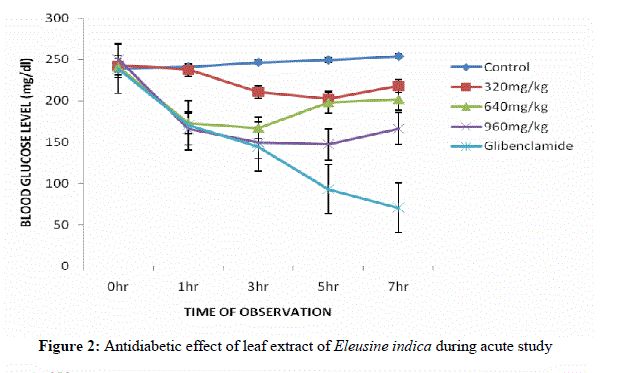 |
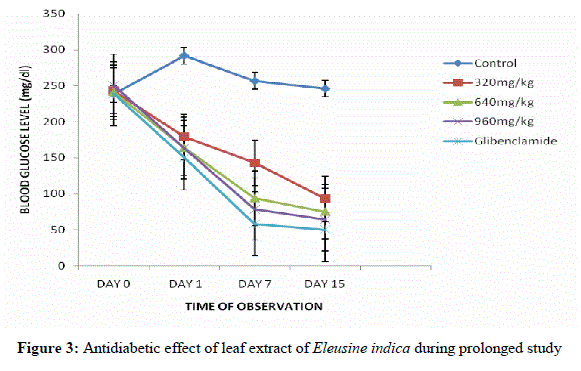 |
| Figure 1 |
Figure 2 |
Figure 3 |
|
| |
